英语副词用法总结(完整)
- 格式:doc
- 大小:55.00 KB
- 文档页数:6

英语副词用法总结副词是一种用来修饰动词、形容词、其他副词、短语或者整个句子的词类。
副词为我们提供了更多的信息来描述或修改其他词或短语的含义。
副词的用法总结如下:1.副词修饰动词:-副词可以用来修饰动词的方式、程度、频率等。
例句:- He ran quickly to catch the bus.- She speaks fluently in English.- They often go hiking on weekends.2.副词修饰形容词或其他副词:-副词可以用来修饰形容词或其他副词,表示程度或方式。
例句:- The weather is extremely hot today.- She sings beautifully.- He drives quite fast.3.副词修饰短语或介词短语:-副词可以用来修饰短语或介词短语,表示方式、程度或时间。
例句:- She walked into the room quietly.- They arrived late for the meeting.- He looked at her lovingly.4.副词修饰整个句子:-副词可以用来修饰整个句子,表示说话者的观点、态度或推测等。
例句:- Frankly, I don't agree with you.- Hopefully, everything will be fine.- Apparently, she didn't receive my message.需要注意的是,副词可以通过在词根后面加上-ly来构成,但并非所有以-ly结尾的词都是副词。
有些以-ly结尾的词是形容词,如friendly、silly等。
当副词修饰动词时,它们通常放在动词之后,但有些情况下它们也可以放在句尾。
副词的位置比较灵活,但需要确保它们与所修饰的词或短语之间的关系明确。
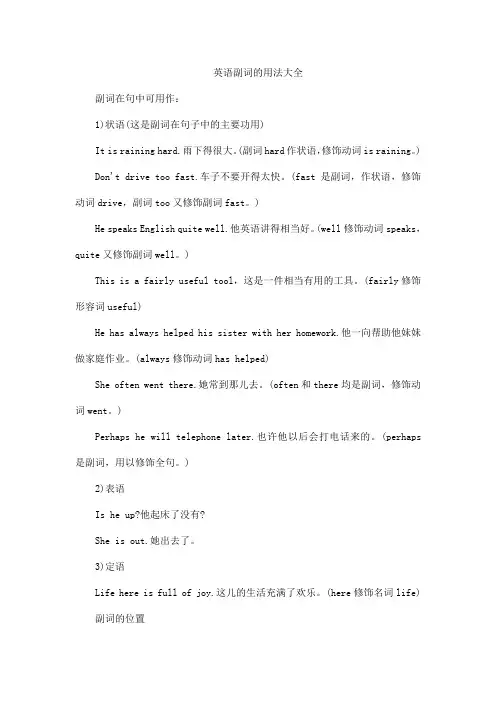
英语副词的用法大全副词在句中可用作:1)状语(这是副词在句子中的主要功用)It is raining hard.雨下得很大。
(副词hard作状语,修饰动词is raining。
) Don't drive too fast.车子不要开得太快。
(fast是副词,作状语,修饰动词drive,副词too又修饰副词fast。
)He speaks English quite well.他英语讲得相当好。
(well修饰动词speaks,quite又修饰副词well。
)This is a fairly useful tool,这是一件相当有用的工具。
(fairly修饰形容词useful)He has always helped his sister with her homework.他一向帮助他妹妹做家庭作业。
(always修饰动词has helped)She often went there.她常到那儿去。
(often和there均是副词,修饰动词went。
)Perhaps he will telephone later.也许他以后会打电话来的。
(perhaps 是副词,用以修饰全句。
)2)表语Is he up?他起床了没有?She is out.她出去了。
3)定语Life here is full of joy.这儿的生活充满了欢乐。
(here修饰名词life) 副词的位置1)修饰动词时,有三种位置。
2)修饰形容词和副词时,须放在被修饰词之前。
如:It is a rather difficult job,这是一件颇为困难的工作。
(rather修饰形容词difficult)He runs very fast.他跑得很快。
(very修饰副词fast)3)副词作定语时,一般放在被修饰的名词之后。
如:The peasants there are busy digging a canal now.那里的农民现在正忙于修水渠。
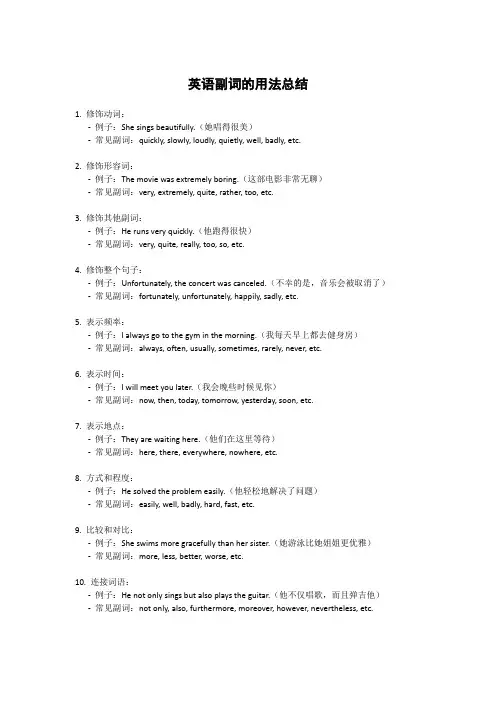
英语副词的用法总结1. 修饰动词:-例子:She sings beautifully.(她唱得很美)-常见副词:quickly, slowly, loudly, quietly, well, badly, etc.2. 修饰形容词:-例子:The movie was extremely boring.(这部电影非常无聊)-常见副词:very, extremely, quite, rather, too, etc.3. 修饰其他副词:-例子:He runs very quickly.(他跑得很快)-常见副词:very, quite, really, too, so, etc.4. 修饰整个句子:-例子:Unfortunately, the concert was canceled.(不幸的是,音乐会被取消了)-常见副词:fortunately, unfortunately, happily, sadly, etc.5. 表示频率:-例子:I always go to the gym in the morning.(我每天早上都去健身房)-常见副词:always, often, usually, sometimes, rarely, never, etc.6. 表示时间:-例子:I will meet you later.(我会晚些时候见你)-常见副词:now, then, today, tomorrow, yesterday, soon, etc.7. 表示地点:-例子:They are waiting here.(他们在这里等待)-常见副词:here, there, everywhere, nowhere, etc.8. 方式和程度:-例子:He solved the problem easily.(他轻松地解决了问题)-常见副词:easily, well, badly, hard, fast, etc.9. 比较和对比:-例子:She swims more gracefully than her sister.(她游泳比她姐姐更优雅)-常见副词:more, less, better, worse, etc.10. 连接词语:-例子:He not only sings but also plays the guitar.(他不仅唱歌,而且弹吉他)-常见副词:not only, also, furthermore, moreover, however, nevertheless, etc.。
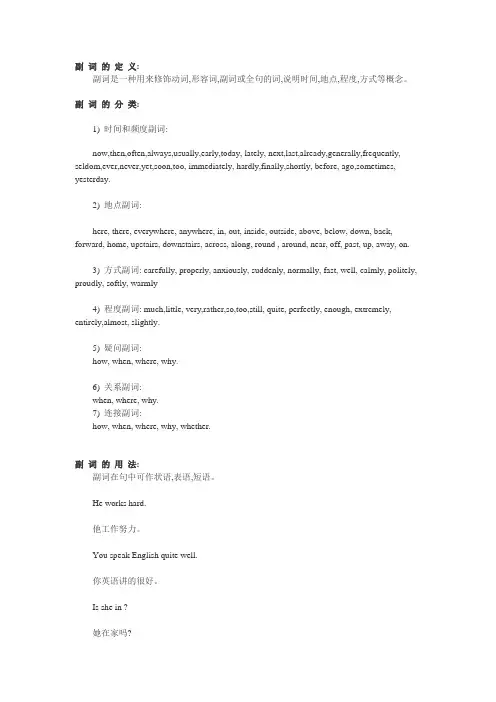
副词的定义:副词是一种用来修饰动词,形容词,副词或全句的词,说明时间,地点,程度,方式等概念。
副词的分类:1) 时间和频度副词:now,then,often,always,usually,early,today, lately, next,last,already,generally,frequently, seldom,ever,never,yet,soon,too, immediately, hardly,finally,shortly, before, ago,sometimes, yesterday.2) 地点副词:here, there, everywhere, anywhere, in, out, inside, outside, above, below, down, back, forward, home, upstairs, downstairs, across, along, round , around, near, off, past, up, away, on.3) 方式副词: carefully, properly, anxiously, suddenly, normally, fast, well, calmly, politely, proudly, softly, warmly4) 程度副词: much,little, very,rather,so,too,still, quite, perfectly, enough, extremely, entirely,almost, slightly.5) 疑问副词:how, when, where, why.6) 关系副词:when, where, why.7) 连接副词:how, when, where, why, whether.副词的用法:副词在句中可作状语,表语,短语。
He works hard.他工作努力。
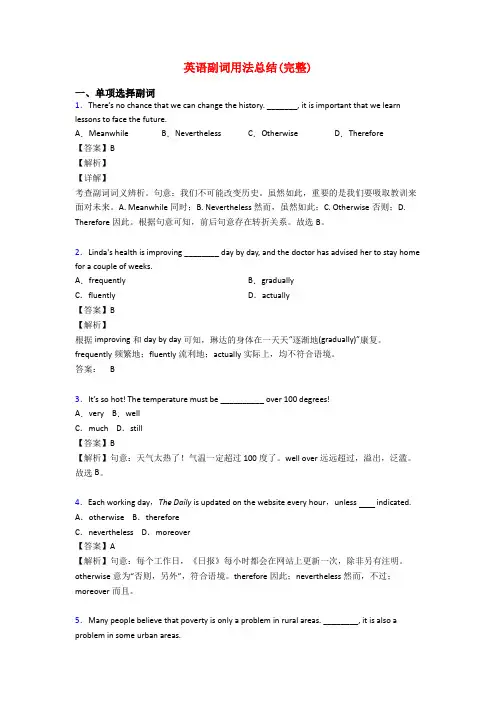
英语副词用法总结(完整)一、单项选择副词1.There’s no chance that we can change the history. _______, it is important that we learn lessons to face the future.A.Meanwhile B.Nevertheless C.Otherwise D.Therefore【答案】B【解析】【详解】考查副词词义辨析。
句意:我们不可能改变历史。
虽然如此,重要的是我们要吸取教训来面对未来。
A. Meanwhile同时;B. Nevertheless然而,虽然如此;C. Otherwise否则;D. Therefore因此。
根据句意可知,前后句意存在转折关系。
故选B。
2.Linda's health is improving ________ day by day, and the doctor has advised her to stay home for a couple of weeks.A.frequently B.graduallyC.fluently D.actually【答案】B【解析】根据improving和day by day可知,琳达的身体在一天天“逐渐地(gradually)”康复。
frequently频繁地;fluently流利地;actually实际上,均不符合语境。
答案:B3.It’s so hot! The temperature must be __________ over 100 degrees!A.very B.wellC.much D.still【答案】B【解析】句意:天气太热了!气温一定超过100度了。
well over 远远超过,溢出,泛滥。
故选B。
4.Each working day,The Daily is updated on the website every hour,unless indicated. A.otherwise B.thereforeC.nevertheless D.moreover【答案】A【解析】句意:每个工作日,《日报》每小时都会在网站上更新一次,除非另有注明。
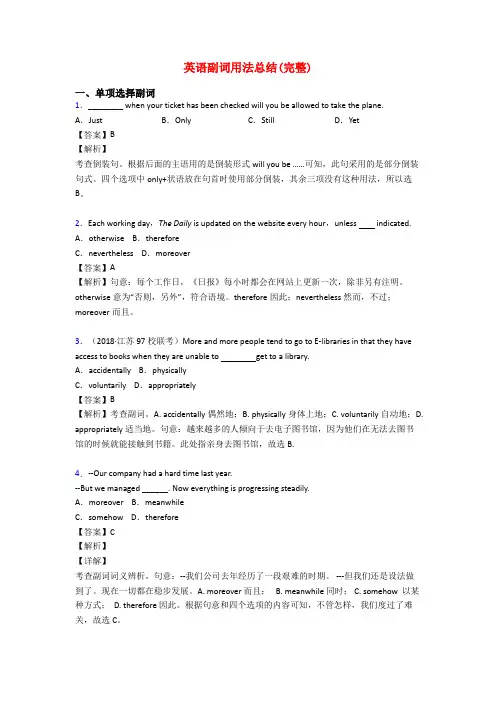
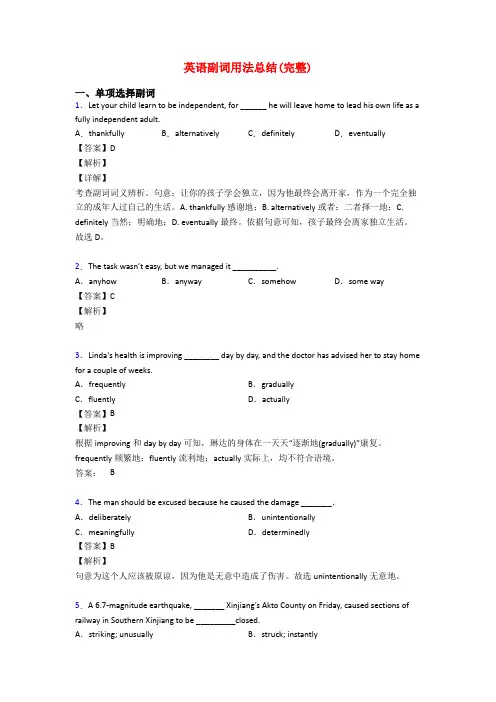

英语副词的用法归纳总结英语副词( Adverbs)是一类词汇,用来修饰动词、形容词、其他副词或整个句子,以表达时间、地点、程度、方式或频率等概念。
以下是英语副词的用法归纳总结:1.(修饰动词•程度副词( Adverbs(of(Degree):(表示程度或强度,如("very" 非常)、"extremely"( 极其)、"quite"( 相当)、"rather"( 有点)、"too" 太)、"enough" 足够)等。
•例句:She(speaks(very(softly.•方式副词 Adverbs(of(Manner):(描述动作或事件的方式,如("slowly" 慢慢地)、"carefully" 小心地)、"quickly" 快速地)、"happily" 快乐地)等。
•例句:He(ran(quickly(to(catch(the(bus.•频率副词 Adverbs(of(Frequency):(表示动作发生的频率,如("always"( 总是)、"often"( 经常)、"sometimes"( 有时候)、"never" 从不)、"rarely" 很少)等。
•例句:She(always(arrives(early(for(work.2.(修饰形容词或其他副词•程度副词 Adverbs(of(Degree):(可以用来修饰形容词或其他副词,以增强或减弱它们的含义。
•例句:The(weather(is(very(hot(today.(She(sings(extremely(well.3.(修饰句子•状语 Adverbial(Phrase):(由一个或多个副词构成的短语,用来修饰整个句子,表达时间、地点、条件、原因等。
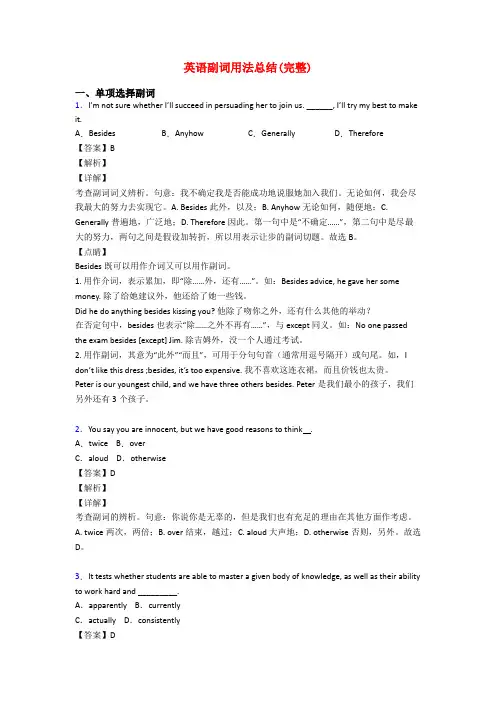
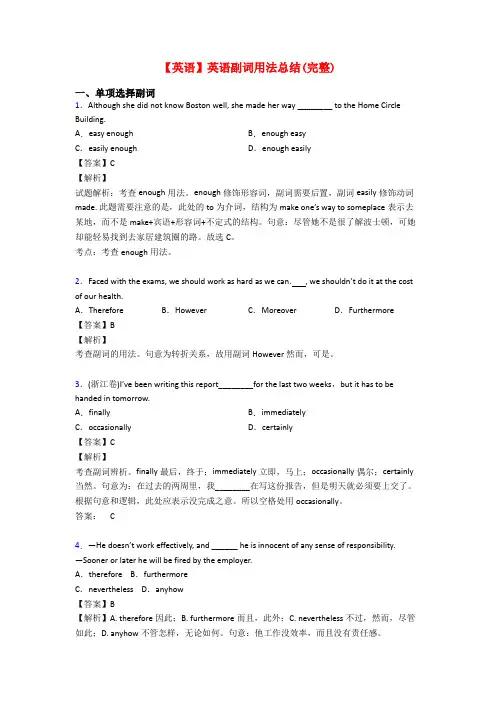
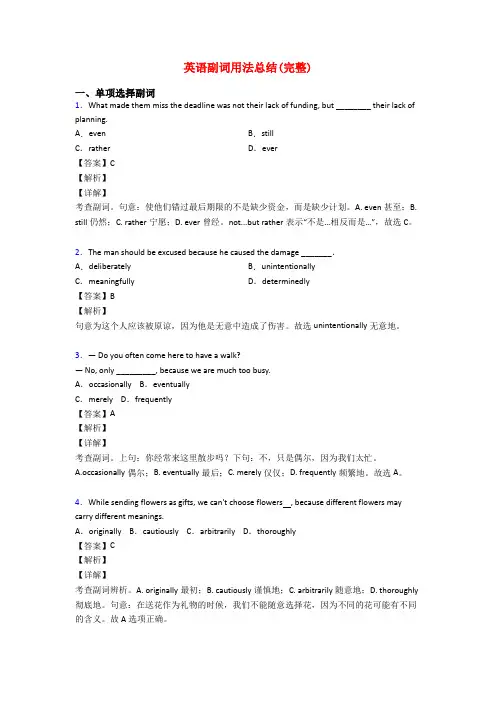
英语副词用法总结(完整)一、单项选择副词1.What made them miss the deadline was not their lack of funding, but ________ their lack of planning.A.even B.stillC.rather D.ever【答案】C【解析】【详解】考查副词。
句意:使他们错过最后期限的不是缺少资金,而是缺少计划。
A. even甚至;B. still仍然;C. rather宁愿;D. ever曾经。
not...but rather表示“不是…相反而是…”,故选C。
2.The man should be excused because he caused the damage _______.A.deliberately B.unintentionallyC.meaningfully D.determinedly【答案】B【解析】句意为这个人应该被原谅,因为他是无意中造成了伤害。
故选unintentionally无意地。
3.— Do you often come here to have a walk?— No, only _________, because we are much too busy.A.occasionally B.eventuallyC.merely D.frequently【答案】A【解析】【详解】考查副词。
上句:你经常来这里散步吗?下句:不,只是偶尔,因为我们太忙。
A.occasionally偶尔;B. eventually最后;C. merely仅仅;D. frequently频繁地。
故选A。
4.While sending flowers as gifts, we can't choose flowers , because different flowers may carry different meanings.A.originally B.cautiously C.arbitrarily D.thoroughly【答案】C【解析】【详解】考查副词辨析。
英语副词用法总结(完整)一、单项选择副词1.The aim of education is to teach young people to think for themselves and not follow others ______ .A.blindly B.unwillingly C.closely D.carefully【答案】A【解析】【详解】考查副词词义辨析。
句意:教育的目的是教年轻人要独立思考而不是盲目地听从他人。
A.blindly盲目的;B.unwillingly不情愿地;C.closely紧密地;D.carefully仔细地。
与前面的think for themselves相对,故选A。
2.— Do you often come here to have a walk?— No, only _________, because we are much too busy.A.occasionally B.eventuallyC.merely D.frequently【答案】A【解析】【详解】考查副词。
上句:你经常来这里散步吗?下句:不,只是偶尔,因为我们太忙。
A.occasionally偶尔;B. eventually最后;C. merely仅仅;D. frequently频繁地。
故选A。
3.I call him ______ ; even when there is not much to say.A.now and then B.by and byC.step by step D.more or less【答案】A【解析】【详解】考查副词短语辨析。
句意:即使没有太多的话要说,我也会时不时的给他打电话。
A. now and then 时而; B. by and by 不就之后; C. step by step 逐步地; D. more or less 或多或少。
根据句意,结合四个选项可知是我时而会给他打电话,故选A.4.China may as well keep its growth above 7 percent. __________, the rate may be set between 6 to 7 percent, for the sake of a healthy environment.A.Consequently B.Alternatively C.Accordingly D.Contrarily【答案】B【解析】【详解】考查副词辨析。
英语中副词及用法规律总结副词是英语中一类非常重要的词类,它可以修饰动词、形容词、其他副词或者整个句子的意义。
在句子中起到了状语的作用,能够表达时间、地点、程度、方式、原因等概念。
本文将对英语中副词的用法进行规律总结。
一、时间状语副词英语中常见的时间状语副词有now(现在)、today(今天)、tomorrow(明天)、yesterday(昨天)、always(总是)、often(经常)、usually(通常)、sometimes(有时候)、rarely(很少)、never (从不)等等。
这些副词通常用于表示动作发生的时间。
例如:- I always brush my teeth before going to bed.(我总是在睡觉前刷牙。
)- He rarely goes to the gym.(他很少去健身房。
)二、地点状语副词英语中常见的地点状语副词有here(这里)、there(那里)、everywhere(到处)、nowhere(无处)、somewhere(某处)、anywhere(任何地方)等等。
这些副词通常用于表示动作发生的地点。
例如:- I can't find my keys anywhere.(我找不到我的钥匙了。
)- There are beautiful flowers everywhere in the garden.(花园里到处都是美丽的花。
)三、方式状语副词英语中常见的方式状语副词有slowly(慢慢地)、quickly(快速地)、carefully(仔细地)、easily(容易地)、quietly(安静地)等等。
这些副词通常用于表示动作进行的方式。
例如:- She speaks English fluently.(她英语说得很流利。
)- The children played happily in the park.(孩子们在公园里开心地玩耍。
)四、程度状语副词英语中常见的程度状语副词有very(非常)、quite(相当)、too (太)、so(如此)、almost(几乎)、only(仅仅)、rather(相当)等等。